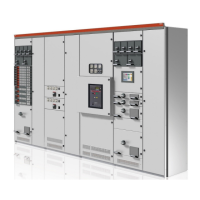07.CO N FI G U R A B L E INPUTS AND OUTPUTS 67
• TOL Bypass
When DI is defined as ‘TOL Bypass’, the input is
used to decide when to activate or deactivate
‘TOL Bypass Function’.
TOL bypass function is the function that allow
TOL tripping level rise temporarily to 200% when
it is activated. That is, when TOL bypass function
is activated, a motor is allowed to continue
running until thermal capacity level reaches 200%
without tripping on TOL and a motor tripped on
TOL is allowed to be restarted immediately in
case of emergency, regardless the thermal level.
To activate TOL bypass function, the parameter
‘TOL bypass” is required to be enabled. The
operation of TOL bypass function is from a
special "TOL Bypass " command either through
local control signals (via digital input hard-wiring)
or given by fieldbus.
If the command comes from local control DIs,
depending on the DI setting, a continuous "0" or
"1" activate the TOL bypass function. A reserve
signal de- activate the function.
If the command comes from PROFIBUS, a
continuous "1" from PROFIBUS activate the
function until a '0" is received.
If the command comes from MODBUS, an
"activate TOL bypass" command activate the
function and a 'deactivate TOL bypass' command
deactivate the function.
A sequence of activating and deactivating a TOL
bypass function via DI is described as following,
• Select parameter ‘TOL bypass’ under TOL
protection section if the motor is expected to
be run exceeding 100% thermal level in case of
emergency;
• Wire a ‘TOL bypass’ control switch to the DI
and define the DI as ‘TOL bypass’;
• Switch on motor and run normally;
• In case of emergency, activate TOL bypass
function through the DI and increase the TOL
level;
• After the emergency situation, de-activate the
function through DI to recover TOL protection.
TOL bypass function increases thermal
capacity level and can cause equipment
overheating and fire. The function must
be limited to applications where
temporarily thermal increase or
immediate restart are vital.
• MD control
MD control is used to decide whether the control
command from MD is active or not. When one of
the digital inputs is assigned as MD control, the
control authority of MD will not be changed via
parameterization but depend on the input status
of the DI. If the input status is active, motor can
be controlled via MD and vice versa.
Although above listed functions
are available to all 13 DI configura-
tion, there are certain functions
which should only be assigned
once to one of the DIs only. These
functions include, Limit1,Limit2,
PLC control1/2, F_CA, F_CB, F_CC,
Loc/ R, and Main switch status

